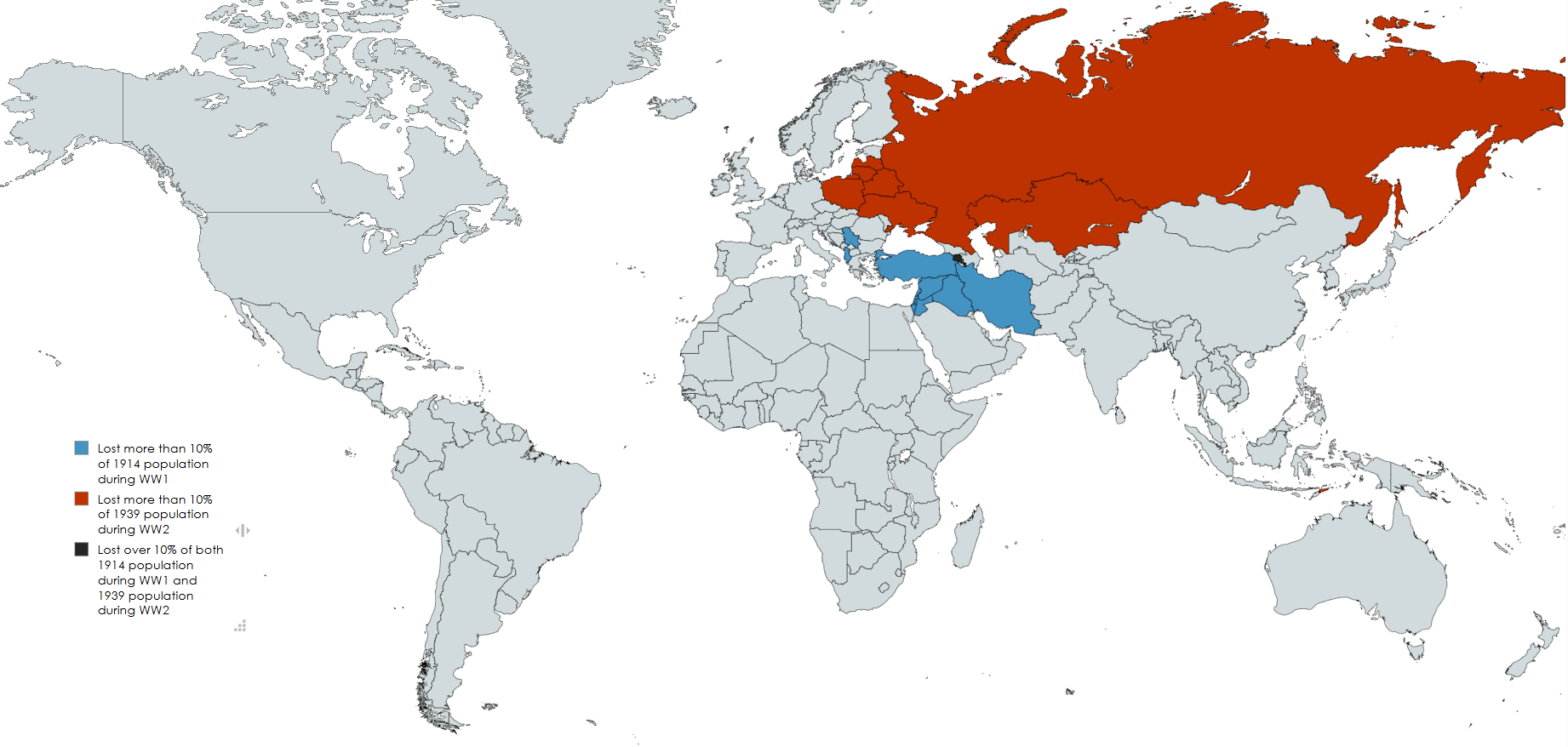Map of Hardest Hit Countries by World Wars


Marcus Rodriguez
Historical Geography Expert
Marcus Rodriguez specializes in historical cartography and geographic data analysis. With a background in both history and geography, he brings unique...
Geographic Analysis
What This Map Shows
This map provides a stark visualization of the countries that were hardest hit by the two World Wars, focusing specifically on those nations where the death toll accounted for more than 10% of the population at the onset of each conflict. The data highlights the profound human cost of these global conflicts, revealing how borders and demographics shifted in the wake of war. Understanding the impact of these wars on specific countries can provide us with insights into how historical events shape modern nations.
Deep Dive into War Impact on Populations
The two World Wars were unprecedented in their scale and brutality, leading to catastrophic loss of life across Europe and beyond. The term 'hardest hit' refers not only to the sheer number of casualties but also to the percentage of the population that perished during these conflicts. For example, Poland, which had a pre-war population of around 35 million, lost an estimated 6 million people during World War II—over 17% of its population. This loss was not just a statistic; it represented a generation of people, families, and entire communities wiped off the map.
Interestingly, the devastation wasn't limited to just one country. Nations like the Soviet Union suffered even more drastic losses. Estimates indicate that the USSR lost around 26 million people during the Second World War, which was roughly 14% of its population at the time. The staggering numbers reflect a broader trend: countries that were on the front lines of major battles often faced the highest casualties.
What’s fascinating is the way these wars affected not just demographics but also the social fabric of these nations. Surviving populations were often left to grapple with the psychological and economic aftermath of such extensive losses. In many cases, entire communities were decimated, leading to a significant shift in cultural identity and social structures.
Moreover, the impact of World War I, while less catastrophic in terms of percentage losses, was still profound. For instance, Germany lost approximately 2 million soldiers, alongside significant civilian casualties. The Treaty of Versailles imposed heavy reparations, leading to economic strife that contributed to the rise of extremist ideologies and, ultimately, World War II.
The effects of the wars were often felt for generations. Cities like Warsaw and Berlin were left in ruins, necessitating extensive rebuilding efforts. Interestingly, these efforts sometimes led to innovative urban designs that shaped the future of these cities. For example, post-war reconstruction in Germany led to a focus on modernist architecture, while Warsaw's reconstruction was a meticulous effort to restore historical buildings, reflecting a desire to reclaim cultural identity.
Regional Analysis
Looking at the regional impact of the World Wars, Europe stands out as the epicenter of devastation. Countries in Central and Eastern Europe, such as Hungary and Romania, faced dramatic population losses. Hungary, for instance, experienced a death toll that equated to roughly 5% of its population during World War I and an even greater loss in World War II, skewing demographic balances significantly.
In contrast, countries like the United States and Canada, while involved in the wars, did not suffer the same level of population loss. The vast geographical distance and the nature of their involvement kept civilian casualties relatively low, making their post-war recovery markedly different.
The Asia-Pacific region also saw significant impacts. Countries like Japan and China faced devastating effects. China, embroiled in its own internal conflicts alongside the war, saw millions die due to both military actions and the ensuing humanitarian crises. In Japan, the war culminated in catastrophic bombings that decimated entire cities, leading to significant loss of life and a long-lasting impact on the Japanese psyche.
Significance and Impact
Understanding the death tolls from the World Wars provides a crucial lens through which we can examine contemporary geopolitical relationships. The scars left on these nations have shaped not only their political landscapes but also their social dynamics and cultural identities. Furthermore, the historical narratives created around these wars continue to influence national identities and policies today.
The legacy of these conflicts is evident in the modern-day struggles of countries that were heavily impacted. Nations continue to deal with the consequences of lost generations, economic hardships, and the need for reconciliation within their populations. Interestingly, as global tensions rise once more, it’s crucial to reflect on how the lessons learned from these catastrophic events can inform our approach to current and future conflicts.
In conclusion, the map detailing the hardest hit countries by the World Wars is not just a representation of numbers; it is a poignant reminder of the human cost of war. It serves as a call to reflect on our collective history and strive towards a more peaceful future, learning from the past to ensure that such losses are never repeated.
Visualization Details
- Published
- September 28, 2025
- Views
- 50
Comments
Loading comments...